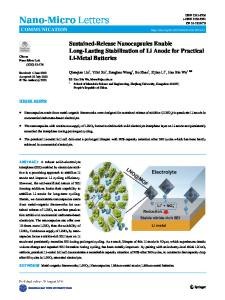Inorganic/polymer hybrid layer stabilizing anode/electrolyte interfaces in solid-state Li metal batteries
- PDF / 1,972,957 Bytes
- 5 Pages / 612 x 808 pts Page_size
- 21 Downloads / 404 Views
ijing National Laboratory for Molecular Sciences (BNLMS), College of Chemistry and Molecular Engineering, Peking University, Beijing 100871,China 2 Department of Chemistry and Energy Sciences Institute, Yale University, West Haven, CT 06516, USA © Tsinghua University Press and Springer-Verlag GmbH Germany, part of Springer Nature 2020 Received: 2 June 2020 / Revised: 17 July 2020 / Accepted: 19 July 2020
ABSTRACT Li1.5Al0.5Ge1.5(PO4)3 (LAGP) is a solid-state electrolyte with high ionic conductivity and air stability but poor chemical stability and high interfacial impedance when directly contacted with Li metal. In this work, we develop an inorganic/polymer hybrid interlayer composed of Li bis(trifluoromethylsulfonyl)imide/poly(vinylene carbonate) polymer electrolyte and SiO2 submicrospheres to stabilize the Li/LAGP interface. The polymeric component renders high ionic conductance and low interfacial resistance, whereas the inorganic component imparts flame retardancy and a physical barrier to the known Li-LAGP side reaction, together enabling stable Li stripping/plating for more than 1,500 h at room temperature. With this interlayer at both electrodes, all-solid-state Li||LiFePO4 full cells with stable cycling performance are also demonstrated.
KEYWORDS Li1.5Al0.5Ge1.5(PO4)3 (LAGP), hybrid interlayer, solid-state electrolyte, Li metal battery, interface
Solid-state electrolytes are receiving extensive attention in battery applications because of their better safety compared to the conventional organic liquid electrolytes [1, 2]. Inorganic ceramics, such as NASICON-type [3–7], sulfide [8–11], perovskitetype [12, 13], and garnet-type [14–17] materials, with high ionic conductivity and mechanical strength, are promising solidstate electrolytes for safe and high-energy-density Li batteries. However, these electrolytes face issues including high solid/ solid interfacial resistance and poor chemical stability in contact with electrode materials [18–20], which limit the development of solid-state batteries. For example, NASICONtype Li1.4Al0.4Ti1.6(PO4)3 (LATP) [21–23] and Li1.5Al0.5Ge1.5(PO4)3 (LAGP) [24–32] have good ionic conductivity (10–4–10–3 S·cm–1) and air stability, but are chemically unstable against Li metal, which cause poor cycling stability. Studies have shown that the degradation mechanism of LAGP involves its reduction by Li resulting in high interfacial resistance and cracking/pulverization of the electrolyte [30–34]. Because of the side reactions, Li|LAGP|Li cells without interfacial modification can only be cycled for less than 150 h at 0.1 mA·cm–2 with a high overpotential (> 300 mV) [30, 31, 33, 35]. Constructing an interlayer between Li and LAGP has emerged as a simple yet effective strategy for mitigating this problem. Both inorganic and polymeric materials have been used as interlayers [32, 36–42]. For example, a Ge thin film was sputtered on LAGP surface to suppress reduction of LAGP and improve its wettability for Li metal [38]. The resulting symmetrical cell could be cycled for 200 h at 0.1 mA·
Data Loading...











